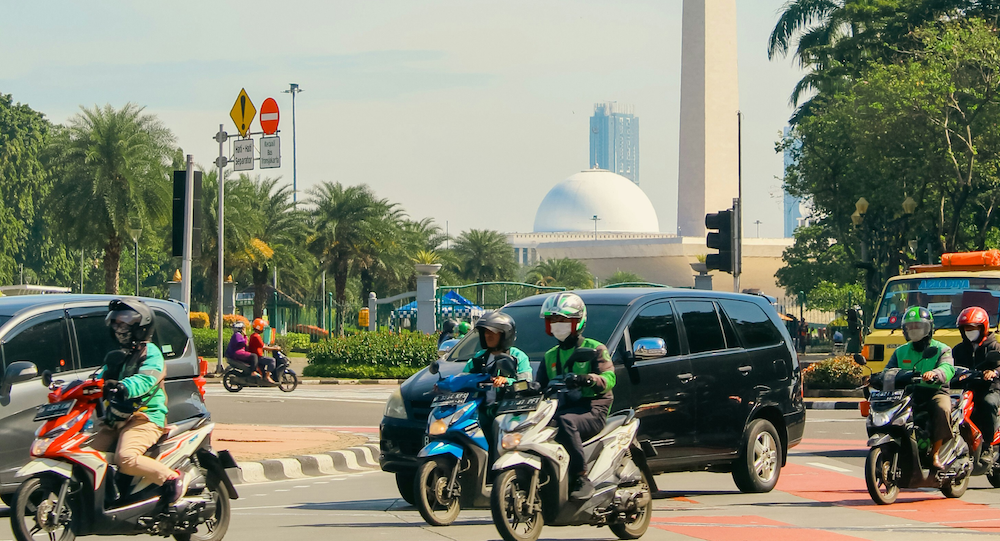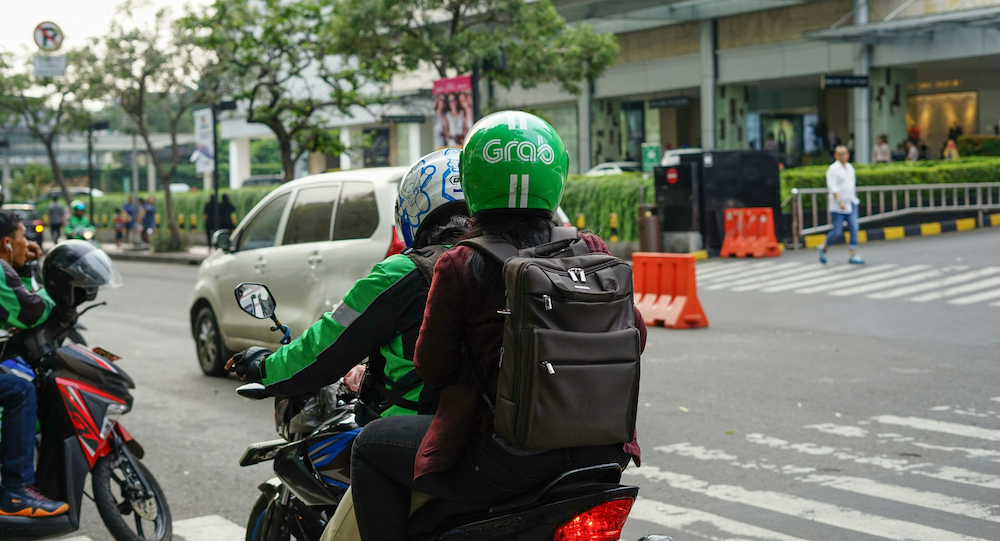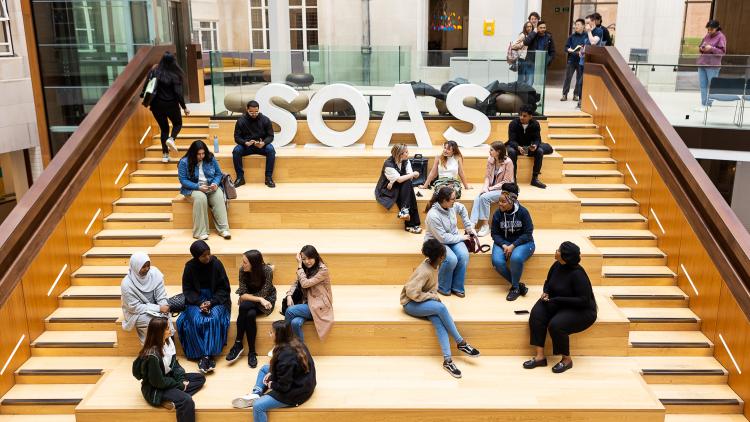Precarity on two wheels: Keep in motion to maintain the balance


The rise of ride-hailing apps in Indonesia has absorbed informal labour into the gig economy. Postgraduate student Kafi Prasetya explores the labour conditions within this sector to assess their impact on the social welfare of the workers.
In January 2015, a local company called Gojek arrived in Indonesia and introduced the motorbike ride-hailing system. This system disrupted the country’s ways of mobilising themselves through dense traffic in urban cities by providing a one-click-away app for someone to pick you up on a two-wheel motorbike. In 2022, research shows that 47.8% of Jakarta’s mass transport users use ride-hailing services for their first-mile or last-mile commuting. It has become a popular mode of transport in Indonesia due to its ease of navigating traffic jams and small alleyways.
The ride-hailing system also seeks to employ the traditional ‘ojek’ drivers, the precarious motorbike taxi drivers who usually linger around mass transit stations or entrance gates of the residential area, waiting for passengers to request their service.
The rise of ‘gig’ economy
The digital emergence popularises a new form of economy known as the gig economy. Although it may serve as a buffer to absorb informal labour, it also blurs the line between formal and informal work, leaving employment rights and duties unclear. Under Indonesian law, ride-hailing app companies designate their drivers as ‘mitra,’ or independent contractors, which sidesteps the traditional framework of formal employment. This arrangement does not obligate these corporations to provide social protections such as health insurance or paid leave.
The drivers also operate with their own vehicles, which transfers the burden of maintenance, fuel, and other operational costs onto them with minimum to no compensation from the company. The scheme allows flexible working hours but provides an unequal income share with 0.5$ per km for short trips and 0.8$ per km for trips above 10 km distance . This forces the drivers to work extra hours to earn sufficient income for their households.
The company has implemented a gamification system aimed at boosting driver productivity.
One study found that ride-hailing app drivers had to leave their homes to work from 15 to almost 18 hours daily to secure a living wage. This unfair scheme not only places a heavy financial strain but also imposes social costs on the drivers. The exhaustive hours separate them from their families for an entire day, preventing them from contributing to care work in their household.
It incentivises drivers to make consistent and frequent daily trips by prompting them to receive more orders. The gamification system had prompted unhealthy competition for drivers by incentivising those who worked more than 12 hours on average.
The condition is a metaphor for the motorbike they ride; they must keep in motion to maintain their balance.
However, this scheme also negatively impacts workers with lower productivity by cutting the number of orders they receive. The uncertainty in orders, manipulated by the scheme, often pushes drivers away from the job. The less productive workers resulted in having a low income from their jobs, forcing them to seek alternative jobs, which tend to go back to the informal sector. On the other hand, drivers who made frequent trips had to endure intense work to survive, forcing them to precarious and intense working conditions.
Precarity of ‘Ojek’ Drivers in Theory
By absorbing the informal ‘ojek’ drivers, ride-hailing app companies one could make a case for their role in facilitating structural change in Indonesia. Arthur Lewis coined the theory by characterising backward economies as having a dual economy consisting of the traditional subsistence alongside modern capitalist sectors. Economic development thus entails a transition towards fully capitalist economy by allocating resources to modern, more productive industry, facilitating a capitalist expansion. The companies that orchestrate this ride hailing services are a part of the large modern industries, and The ride-hailing app industry has contributed 2% of Indonesian GDP in 2022, or 24 billion USD annually.
However, the transition of the old informal ‘ojek’ drivers to ‘mitra’ drivers does not necessarily change the nature of work towards more secure jobs and neither does it account for the burden of hidden costs given to the drivers. An increase in the overall output of national income does not always mean an increase in social welfare. In fact, the precarity of the job that often forces the ‘mitra’ driver to transition from this employment to other informal jobs for securing livelihood, raises questions on the role of the gig economy in providing an alternative secure means of livelihood for the informal labour. The precarity and process of transitioning from one informal job to another is also evident in India.
Research finds that populations engaged with informality seem to be in a ‘constant state of flux,’ transitioning across categories of precarious jobs in search of viable income while reproducing the informal spaces. For example, drivers who cannot earn sufficient income from one ride-hailing app orders had to be a ‘double agent’, taking orders from other ride-hailing app even though it is prohibited from the company. In other instances, A study revealed that some ride-hailing drivers in Indonesia resorted to ‘pawning’ their accounts – a process of transferring the ability to receive ride orders to a third party in exchange for immediate cash, giving them extra money and allowing them to find other informal work to redeem their account back.
Rethinking employment in the gig economy
The relationship between drivers and companies is structured to align in a neoliberal playbook, a set of methods that includes (mis)classifying workers and employing the most economically vulnerable population. It aims to exert competitiveness in individual scale and squeeze as every point of productivity as possible for companies’ capital accumulation.
The ‘mitra’ scheme provides the drivers individual freedom to set their working hours yet creates a system where they cannot work less than considered profitable. It also liberates companies from labour and employment laws by denying drivers from formal employment. It exploits the pre-existing condition of precarity by providing grey job opportunities.
Asserting the individual responsibility to drivers via the gamification system blurs the companies’ responsibility to provide social security for the workers.
It fabricates the drivers to compete against each other to achieve the highest incentives and punishes the less competitive drivers. It became clear that the current gig system exploits vulnerable populations in precarious work, offering a marginally better alternative work to traditional ‘ojek’ drivers yet perpetuating a cycle of precarious livelihoods.
Under such conditions, despite this gig economy posits an opportunity to absorb the surplus of informal labour in the form of a gig economy, it falls markedly short of providing labour market conditions that are envisaged in event of a successful structural change as was expected through the growth of industrial manufacturing sector.
Header Image credit: Kaja Sariwating via Unsplash.
About the author
Kafi Prasetya is an MSc Environment, Politics and Development student at SOAS University of London. He is an Indonesian with research interests related to climate change, industrialisation, and economic development in late-developed countries.




